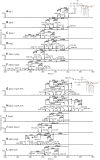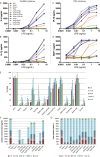Modulating endotoxin activity by combinatorial bioengineering of meningococcal lipopolysaccharide
- PMID: 27841285
- PMCID: PMC5107901
- DOI: 10.1038/srep36575
Modulating endotoxin activity by combinatorial bioengineering of meningococcal lipopolysaccharide
Abstract
Neisseria meningitidis contains a very potent hexa-acylated LPS that is too toxic for therapeutic applications. We used systematic molecular bioengineering of meningococcal LPS through deletion of biosynthetic enzymes in combination with induction of LPS modifying enzymes to yield a variety of novel LPS mutants with changes in both lipid A acylation and phosphorylation. Mass spectrometry was used for detailed compositional determination of the LPS molecular species, and stimulation of immune cells was done to correlate this with endotoxic activity. Removal of phosphethanolamine in lipid A by deletion of lptA slightly reduces activity of hexa-acylated LPS, but this reduction is even more evident in penta-acylated LPS. Surprisingly, expression of PagL deacylase in a penta-acylated lpxL1 mutant increased LPS activity, contradicting the general rule that tetra-acylated LPS is less active than penta-acylated LPS. Further modification included expression of lpxP, an enzyme known to add a secondary 9-hexadecenoic acid to the 2' acyl chain. The LpxP enzyme is temperature-sensitive, enabling control over the ratio of expressed modified hexa- and penta-acylated LPS by simply changing the growth temperature. These LPS derivatives display a broad range of TLR4 activity and differential cytokine induction, which can be exploited for use as vaccine adjuvant or other TLR4-based therapeutics.
Figures





Similar articles
-
Modification of lipid A biosynthesis in Neisseria meningitidis lpxL mutants: influence on lipopolysaccharide structure, toxicity, and adjuvant activity.Infect Immun. 2001 Oct;69(10):5981-90. doi: 10.1128/IAI.69.10.5981-5990.2001. Infect Immun. 2001. PMID: 11553534 Free PMC article.
-
Lipopolysaccharide engineering in Neisseria meningitidis: structural analysis of different pentaacyl lipid A mutants and comparison of their modified agonist properties.J Biol Chem. 2014 Mar 21;289(12):8668-80. doi: 10.1074/jbc.M114.554345. Epub 2014 Feb 3. J Biol Chem. 2014. PMID: 24492609 Free PMC article.
-
Naturally occurring lipid A mutants in neisseria meningitidis from patients with invasive meningococcal disease are associated with reduced coagulopathy.PLoS Pathog. 2009 Apr;5(4):e1000396. doi: 10.1371/journal.ppat.1000396. Epub 2009 Apr 24. PLoS Pathog. 2009. PMID: 19390612 Free PMC article.
-
Variation, Modification and Engineering of Lipid A in Endotoxin of Gram-Negative Bacteria.Int J Mol Sci. 2021 Feb 25;22(5):2281. doi: 10.3390/ijms22052281. Int J Mol Sci. 2021. PMID: 33668925 Free PMC article. Review.
-
Lipopolysaccharide lipid A: A promising molecule for new immunity-based therapies and antibiotics.Pharmacol Ther. 2022 Feb;230:107970. doi: 10.1016/j.pharmthera.2021.107970. Epub 2021 Aug 25. Pharmacol Ther. 2022. PMID: 34454000 Review.
Cited by
-
Boosting Vaccine Research: The 16-Year Journey of TRANSVAC Vaccine Infrastructure.Vaccines (Basel). 2024 Dec 22;12(12):1446. doi: 10.3390/vaccines12121446. Vaccines (Basel). 2024. PMID: 39772106 Free PMC article. Review.
-
Application of Outer Membrane Protein-Based Vaccines Against Major Bacterial Fish Pathogens in India.Front Immunol. 2020 Jul 21;11:1362. doi: 10.3389/fimmu.2020.01362. eCollection 2020. Front Immunol. 2020. PMID: 32849496 Free PMC article. Review.
-
Substrate structure-activity relationship reveals a limited lipopolysaccharide chemotype range for intestinal alkaline phosphatase.J Biol Chem. 2019 Dec 13;294(50):19405-19423. doi: 10.1074/jbc.RA119.010836. Epub 2019 Nov 8. J Biol Chem. 2019. PMID: 31704704 Free PMC article.
-
Surface Glucan Structures in Aeromonas spp.Mar Drugs. 2021 Nov 22;19(11):649. doi: 10.3390/md19110649. Mar Drugs. 2021. PMID: 34822520 Free PMC article. Review.
-
Presence of 2-hydroxymyristate on endotoxins is associated with death in neonates with Enterobacter cloacae complex septic shock.iScience. 2021 Jul 30;24(8):102916. doi: 10.1016/j.isci.2021.102916. eCollection 2021 Aug 20. iScience. 2021. PMID: 34409274 Free PMC article.
References
-
- Loppnow H. et al.. IL-1 induction-capacity of defined lipopolysaccharide partial structures. Journal of immunology 142, 3229–3238 (1989). - PubMed
MeSH terms
Substances
LinkOut - more resources
Full Text Sources
Other Literature Sources

